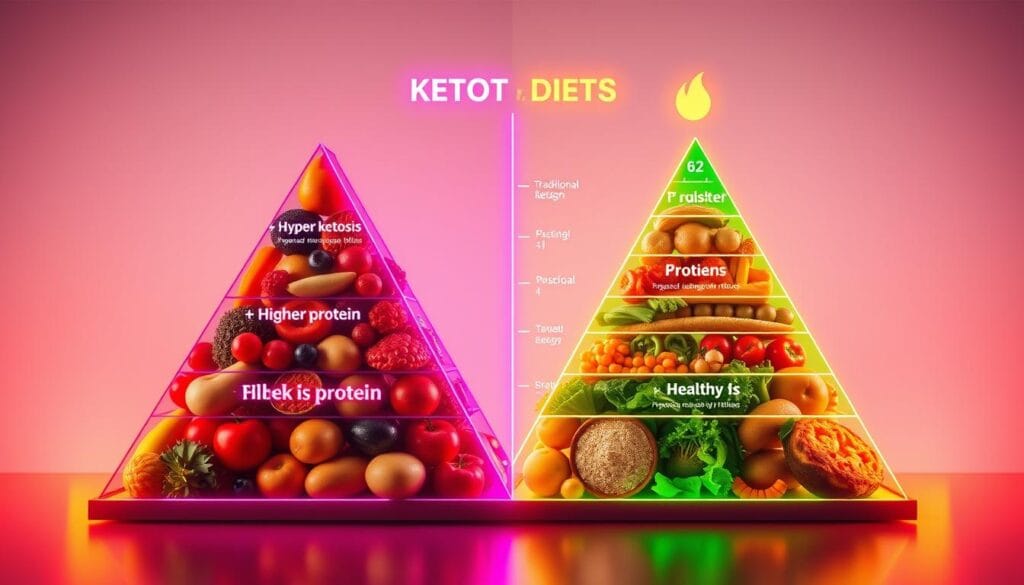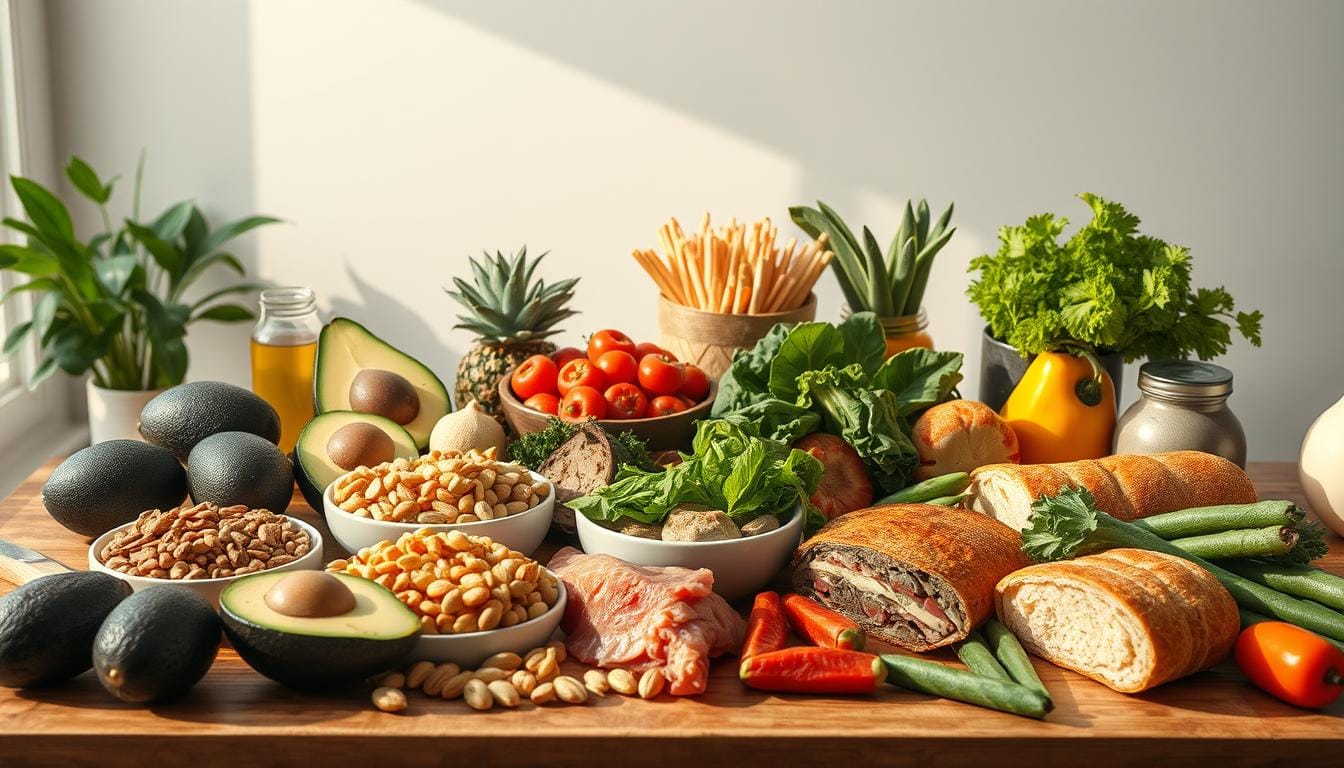Is the Hyper Ketosis Diet Right for You
Imagine waking up every day feeling full of energy. Your body feels lighter and more agile than it has in years. Many people seek effective weight loss strategies, and the hyper ketosis diet is an extreme option.
It promises quick results and many benefits of ketosis. But is it right for you? Before starting this high-fat, low-carb diet, it’s important to know its effects on your body and health. Finding the right diet for your wellness journey is personal and crucial.
Table of Contents
Understanding the Hyper Ketosis Diet
The hyper ketosis diet is all about cutting down carbs and eating more fat. You get only 5% of your calories from carbs, 20% from protein, and 75% from fats. This helps your body switch from using carbs to fat for energy.
This diet is like the traditional ketogenic diet but more intense. It aims to get you into ketosis fast. This can lead to better weight loss and more energy.
What is Ketosis?
Ketosis is a state where your body uses fats for energy instead of carbs. This happens when you eat fewer carbs. Your body then turns fats into ketones for energy.
It takes about 3 to 4 days to enter ketosis on a low-carb diet. Once you’re in ketosis, you might feel less hungry. This makes it easier to stick to your diet. You also start losing fat, which is why many people choose this diet.
Knowing about ketosis helps you make better food choices. It’s great for losing weight, getting more energy, or improving your mind.
How the Hyper Ketosis Diet Works
The hyper ketosis diet cuts down on carbs to less than 50 grams a day. This big cut forces your body to use fats for energy instead of carbs. It’s a more intense version of the keto diet, speeding up fat burning and making ketones in your blood.
Ketones are a new energy source, boosting your energy and helping with weight loss. To do this diet right, you need to plan your meals carefully. You must follow certain ratios of macronutrients to get enough energy and nutrients.
Success with the hyper ketosis diet depends on managing your food well. You need to keep the right balance of fats, proteins, and low carbs.
Hyper Ketosis Diet vs. Traditional Ketogenic Diet
The hyper ketosis diet and the traditional ketogenic diet are two different ways to eat low-carb. Both aim to get you into ketosis, but they differ in how you get there. They also vary in what you eat and how fast you can get into ketosis.
Differences in Carb, Protein, and Fat Ratios
The biggest difference is in carbs. Traditional ketogenic diets let you eat about 5-10% of your calories from carbs. The hyper ketosis diet cuts this down to about 5%. This means you eat more fat, up to 75% of your diet, and keep protein at 20%.
| Diet Type | Carbohydrates (%) | Protein (%) | Fat (%) |
|---|---|---|---|
| Traditional Ketogenic Diet | 5-10 | 20 | 70-75 |
| Hyper Ketosis Diet | 5 | 20 | 75 |
Achievement of Ketosis
Getting into ketosis is different for each diet. The hyper ketosis diet helps you get into ketosis faster because it limits carbs so much. People might enter ketosis in just a few days on this diet. Traditional ketogenic diets might take longer, making the hyper ketosis diet a quicker option for some.

Benefits of the Hyper Ketosis Diet
The hyper ketosis diet offers many benefits that people enjoy. It helps with quick weight loss and boosts energy levels. Knowing these advantages can help you see if this diet fits your health goals.
Rapid Weight Loss Potential
The hyper ketosis diet is great for losing weight fast. It makes your body burn fat instead of carbs. You might lose water weight first, but it leads to lasting fat loss with careful calorie control.
Many people see changes in their body shape. This motivates them to keep going on their ketosis weight loss journey.
Increased Energy and Reduced Hunger
This diet also increases your energy and reduces hunger. By using fat as your main energy source, you stay energized all day. Many feel less hungry, making it easier to do physical activities or handle daily tasks.
This mix of more energy and less hunger improves your mental and physical performance. It makes your day more productive.
Risks Associated with the Hyper Ketosis Diet
The hyper ketosis diet has many benefits, but it also comes with risks. These risks mainly involve not getting enough nutrients and problems with heart health. Eating very little can lead to health issues.
Nutrient Deficiencies on a Highly Restrictive Diet
By cutting out certain foods, you might not get enough vitamins and minerals. This can cause feelings of tiredness, irritability, and constipation. It’s important to watch what you eat to stay healthy.
Possible Effects on Heart Health
While fats are good, too much saturated fat can harm your heart. It’s key to keep an eye on how much saturated fat you eat. This helps prevent heart problems.
| Risk Factor | Description |
|---|---|
| Nutrient Deficiency | Reduced intake of essential vitamins and minerals leading to fatigue and irritability. |
| Heart Health Concerns | Increased risk of cardiovascular disease due to high saturated fat consumption. |
| Keto-Flu Symptoms | Experiencing flu-like symptoms such as headaches and nausea from diet changes. |
Meal Planning for the Hyper Ketosis Diet
Planning your meals is key to doing well on the hyper ketosis diet. It’s about sticking to certain ratios of macronutrients and getting all the nutrients you need. Eating a variety of foods helps keep this balance all day long.
Essential Foods for Your Meal Plan
When making a ketosis meal plan, include these important foods:
- Healthy Fats: Olive oil, avocados, and a mix of nuts.
- Lean Proteins: Chicken, turkey, fish, and plant-based proteins.
- Non-Starchy Vegetables: Cruciferous veggies like broccoli, and leafy greens like spinach and kale.
These foods help you meet the diet’s macronutrient needs. They also give you important vitamins and minerals.
Sample Hyper Ketosis Meal Plan
A sample meal plan might look like this:
| Meal | Menu |
|---|---|
| Breakfast | Eggs cooked in olive oil with sautéed spinach. |
| Lunch | Grilled chicken with a salad of mixed greens and avocado. |
| Dinner | Salmon fillet with steamed broccoli and olive oil. |
| Snacks | Nuts or cheese. |
This plan focuses on low-carb, high-fat foods. They help keep your energy up and support your diet goals.
Hyper Ketosis Diet Recipes You Can Try
Adding tasty and fulfilling ketosis recipes to your hyper ketosis diet can keep you motivated. Here are a few easy recipes to try:
- Cauliflower Rice Stir-Fry: This dish is a great low-carb substitute for regular rice stir-fries. Cook cauliflower rice with your favorite protein and colorful veggies for a tasty meal.
- Avocado Egg Salad: Mix mashed avocado with boiled eggs, a bit of salt, pepper, and herbs for a creamy, healthy salad.
- Creamy Keto Chicken Casserole: This casserole combines cream cheese, shredded chicken, and various veggies for a filling dish that everyone will love.
These recipes focus on low-carb ingredients but still offer great flavors. They make it easier to stay on track with your diet.

| Recipe | Main Ingredients | Preparation Time |
|---|---|---|
| Cauliflower Rice Stir-Fry | Cauliflower, Mixed Vegetables, Chicken or Tofu | 15 Minutes |
| Avocado Egg Salad | Avocado, Boiled Eggs, Herbs | 10 Minutes |
| Creamy Keto Chicken Casserole | Shredded Chicken, Cream Cheese, Vegetables | 30 Minutes |
Trying out different ketosis recipes can make your diet more varied. It can also make your time on the hyper ketosis diet more enjoyable.
Who Should Avoid the Hyper Ketosis Diet?
The hyper ketosis diet is good for many, but not for everyone. People with a history of eating disorders should be careful. The diet’s strict rules might make their food-related issues worse.
Those with kidney disease should think twice about this diet. It has a lot of protein, which can be hard on the kidneys. It’s also not good for people with pancreatitis or liver problems because of its high fat content.
Pregnant or breastfeeding women should be careful with this diet. They need more nutrients, and strict diets might not provide enough. Also, people taking certain diabetes medications should talk to their doctors first. Changing diets can lead to bad reactions.
It’s important to make sure your diet fits your health needs. This helps you stay healthy and well.
Consulting with a Professional: A Smart Move
Before starting the hyper ketosis diet, it’s wise to talk to experts. Healthcare providers like registered dietitians or nutritionists can help. They know how to look at your health and what you can eat safely.
They give advice that fits your needs. This helps you avoid risks and make smart choices. It’s not just about following a trend; it’s about your health.
Getting help from professionals is a smart choice. It makes sure your diet is good for you. You focus on your health and success.
| Consultation Benefits | Description |
|---|---|
| Individual Assessment | Personalized evaluation of health status and dietary needs. |
| Risk Mitigation | Identifying potential risks of adopting the diet without support. |
| Nutritional Guidance | Advice on how to meet your macro and micronutrient needs. |
| Long-term Success | Strategies for sustaining the positive effects of the diet. |
Conclusion
The hyper ketosis diet offers promising benefits for weight management and energy. But, it’s important to understand it well. Its strict rules mean you must weigh the good and bad sides to see if it’s right for you.
Before starting, talk to a healthcare expert. They can help you decide if this diet is safe for you. They’ll also help create a plan that fits your health needs.
Remember, what works for someone else might not work for you. Take time to think about if the hyper ketosis diet is good for you. Consider how it fits into your life and health goals.

